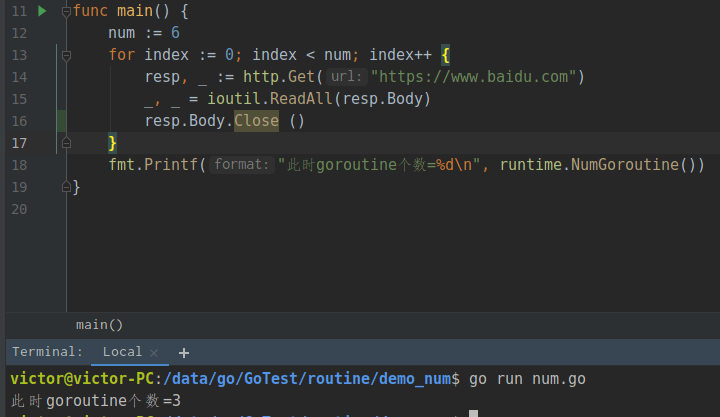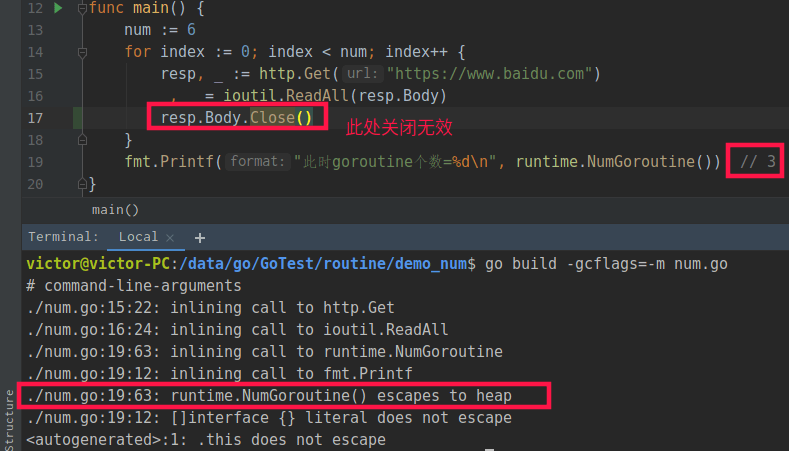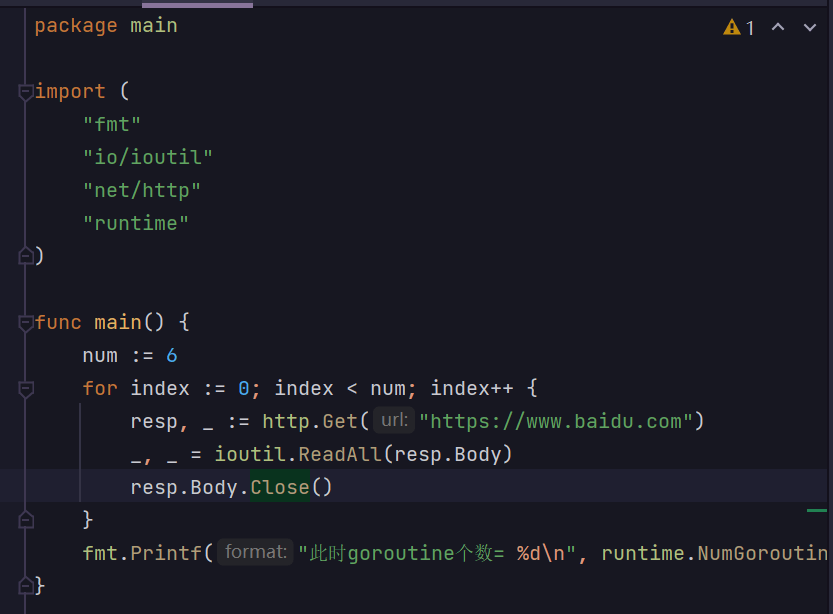给大家丢脸了,用了三年golang,我还是没答对这道内存泄漏题
问题
package main
import (
"fmt"
"io/ioutil"
"net/http"
"runtime"
)
func main() {
num := 6
for index := 0; index < num; index++ {
resp, _ := http.Get("https://www.baidu.com")
_, _ = ioutil.ReadAll(resp.Body)
}
fmt.Printf("此时goroutine个数= %d\n", runtime.NumGoroutine())
}
上面这道题在不执行resp.Body.Close()的情况下,泄漏了吗?如果泄漏,泄漏了多少个goroutine?
怎么答
- 不进行
resp.Body.Close(),泄漏是一定的。但是泄漏的goroutine个数就让我迷糊了。由于执行了6遍,每次泄漏一个读和写goroutine,就是12个goroutine,加上main函数本身也是一个goroutine,所以答案是13. - 然而执行程序,发现答案是3,出入有点大,为什么呢?
解释
- 我们直接看源码。
golang的http包。
http.Get()
-- DefaultClient.Get
----func (c *Client) do(req *Request)
------func send(ireq *Request, rt RoundTripper, deadline time.Time)
-------- resp, didTimeout, err = send(req, c.transport(), deadline)
// 以上代码在 go/1.12.7/libexec/src/net/http/client:174
func (c *Client) transport() RoundTripper {
if c.Transport != nil {
return c.Transport
}
return DefaultTransport
}- 说明
http.Get默认使用DefaultTransport管理连接。DefaultTransport是干嘛的呢?// It establishes network connections as needed // and caches them for reuse by subsequent calls. DefaultTransport的作用是根据需要建立网络连接并缓存它们以供后续调用重用。那么
接着上面的代码堆栈往下翻DefaultTransport什么时候会建立连接呢?
func send(ireq *Request, rt RoundTripper, deadline time.Time)
--resp, err = rt.RoundTrip(req) // 以上代码在 go/1.12.7/libexec/src/net/http/client:250
func (t *Transport) RoundTrip(req *http.Request)
func (t *Transport) roundTrip(req *Request)
func (t *Transport) getConn(treq *transportRequest, cm connectMethod)
func (t *Transport) dialConn(ctx context.Context, cm connectMethod) (*persistConn, error) {
...
go pconn.readLoop() // 启动一个读goroutine
go pconn.writeLoop() // 启动一个写goroutine
return pconn, nil
}- 一次建立连接,就会启动一个
读goroutine和写goroutine。这就是为什么一次http.Get()会泄漏两个goroutine的来源。 - 泄漏的来源知道了,也知道是因为没有执行
close
那为什么不执行 close 会泄漏呢?
回到刚刚启动的
读goroutine的readLoop()代码里func (pc *persistConn) readLoop() { alive := true for alive { ... // Before looping back to the top of this function and peeking on // the bufio.Reader, wait for the caller goroutine to finish // reading the response body. (or for cancelation or death) select { case bodyEOF := <-waitForBodyRead: pc.t.setReqCanceler(rc.req, nil) // before pc might return to idle pool alive = alive && bodyEOF && !pc.sawEOF && pc.wroteRequest() && tryPutIdleConn(trace) if bodyEOF { eofc <- struct{}{} } case <-rc.req.Cancel: alive = false pc.t.CancelRequest(rc.req) case <-rc.req.Context().Done(): alive = false pc.t.cancelRequest(rc.req, rc.req.Context().Err()) case <-pc.closech: alive = false } ... } }简单来说
readLoop就是一个死循环,只要alive为true,goroutine就会一直存在select里是goroutine有可能退出的场景:body被读取完毕或body关闭request主动cancelrequest的context Done状态true- 当前的
persistConn关闭
其中第一个
body被读取完或关闭这个case:alive = alive && bodyEOF && !pc.sawEOF && pc.wroteRequest() && tryPutIdleConn(trace)bodyEOF来源于到一个通道waitForBodyRead,这个字段的true和false直接决定了alive变量的值(alive=true那读goroutine继续活着,循环,否则退出goroutine)。
那么这个通道的值是从哪里过来的呢?
// go/1.12.7/libexec/src/net/http/transport.go: 1758
body := &bodyEOFSignal{
body: resp.Body,
earlyCloseFn: func() error {
waitForBodyRead <- false
<-eofc // will be closed by deferred call at the end of the function
return nil
},
fn: func(err error) error {
isEOF := err == io.EOF
waitForBodyRead <- isEOF
if isEOF {
<-eofc // see comment above eofc declaration
} else if err != nil {
if cerr := pc.canceled(); cerr != nil {
return cerr
}
}
return err
},
}- 如果执行
earlyCloseFn,waitForBodyRead通道输入的是false,alive也会是false,那readLoop()这个goroutine就会退出。 - 如果执行
fn,其中包括正常情况下body读完数据抛出io.EOF时的case,waitForBodyRead通道输入的是true,那alive会是true,那么readLoop()这个goroutine就不会退出,同时还顺便执行了tryPutIdleConn(trace)。
// tryPutIdleConn adds pconn to the list of idle persistent connections awaiting
// a new request.
// If pconn is no longer needed or not in a good state, tryPutIdleConn returns
// an error explaining why it wasn't registered.
// tryPutIdleConn does not close pconn. Use putOrCloseIdleConn instead for that.
func (t *Transport) tryPutIdleConn(pconn *persistConn) errortryPutIdleConn将pconn添加到等待新请求的空闲持久连接列表中,也就是之前说的连接会复用。
那么问题又来了,什么时候会执行这个 fn 和 earlyCloseFn 呢?
func (es *bodyEOFSignal) Close() error {
es.mu.Lock()
defer es.mu.Unlock()
if es.closed {
return nil
}
es.closed = true
if es.earlyCloseFn != nil && es.rerr != io.EOF {
return es.earlyCloseFn() // 关闭时执行 earlyCloseFn
}
err := es.body.Close()
return es.condfn(err)
}- 上面这个其实就是我们比较收悉的
resp.Body.Close(),在里面会执行earlyCloseFn,也就是此时readLoop()里的waitForBodyRead通道输入的是false,alive也会是false,那readLoop()这个goroutine就会退出,goroutine不会泄露。
b, err = ioutil.ReadAll(resp.Body)
--func ReadAll(r io.Reader)
----func readAll(r io.Reader, capacity int64)
------func (b *Buffer) ReadFrom(r io.Reader)
// go/1.12.7/libexec/src/bytes/buffer.go:207
func (b *Buffer) ReadFrom(r io.Reader) (n int64, err error) {
for {
...
m, e := r.Read(b.buf[i:cap(b.buf)]) // 看这里,是body在执行read方法
...
}
}- 这个
read,其实就是bodyEOFSignal里的func (es *bodyEOFSignal) Read(p []byte) (n int, err error) { ... n, err = es.body.Read(p) if err != nil { ... // 这里会有一个io.EOF的报错,意思是读完了 err = es.condfn(err) } return } func (es *bodyEOFSignal) condfn(err error) error { if es.fn == nil { return err } err = es.fn(err) // 这了执行了 fn es.fn = nil return err } - 上面这个其实就是我们比较收悉的读取
body里的内容。ioutil.ReadAll(),在读完body的内容时会执行fn,也就是此时readLoop()里的waitForBodyRead通道输入的是true,alive也会是true,那readLoop()这个goroutine就不会退出,goroutine会泄露,然后执行tryPutIdleConn(trace)把连接放回池子里复用。总结
- 所以结论呼之欲出了,虽然执行了
6次循环,而且每次都没有执行Body.Close(),就是因为执行了ioutil.ReadAll()把内容都读出来了,连接得以复用,因此只泄漏了一个读goroutine和一个写goroutine,最后加上main goroutine,所以答案就是3个goroutine。 - 从另外一个角度说,正常情况下我们的代码都会执行
ioutil.ReadAll(),但如果此时忘了resp.Body.Close(),确实会导致泄漏。但如果你调用的域名一直是同一个的话,那么只会泄漏一个读goroutine和一个写goroutine,这就是为什么代码明明不规范但却看不到明显内存泄漏的原因。 - 那么问题又来了,为什么上面要特意强调是同一个域名呢?改天,回头,以后有空再说吧。
文章推荐:
- 连nil切片和空切片一不一样都不清楚?那BAT面试官只好让你回去等通知了。
- 昨天那个在for循环里append元素的同事,今天还在么?
- golang面试官:for select时,如果通道已经关闭会怎么样?如果只有一个case呢?
- golang面试官:for select时,如果通道已经关闭会怎么样?如果只有一个case呢?
- golang面试题:对已经关闭的的chan进行读写,会怎么样?为什么?
- golang面试题:对未初始化的的chan进行读写,会怎么样?为什么?
- golang 面试题:reflect(反射包)如何获取字段 tag?为什么 json 包不能导出私有变量的 tag?
- golang面试题:json包变量不加tag会怎么样?
- golang面试题:怎么避免内存逃逸?
- golang面试题:简单聊聊内存逃逸?
- golang面试题:字符串转成byte数组,会发生内存拷贝吗?
- golang面试题:翻转含有中文、数字、英文字母的字符串
- golang面试题:拷贝大切片一定比小切片代价大吗?
- golang面试题:能说说uintptr和unsafe.Pointer的区别吗?
如果你想每天学习一个知识点,关注我的【公】【众】【号】【golang小白成长记】。
本作品采用《CC 协议》,转载必须注明作者和本文链接



 明明是5
明明是5





 关于 LearnKu
关于 LearnKu




推荐文章: